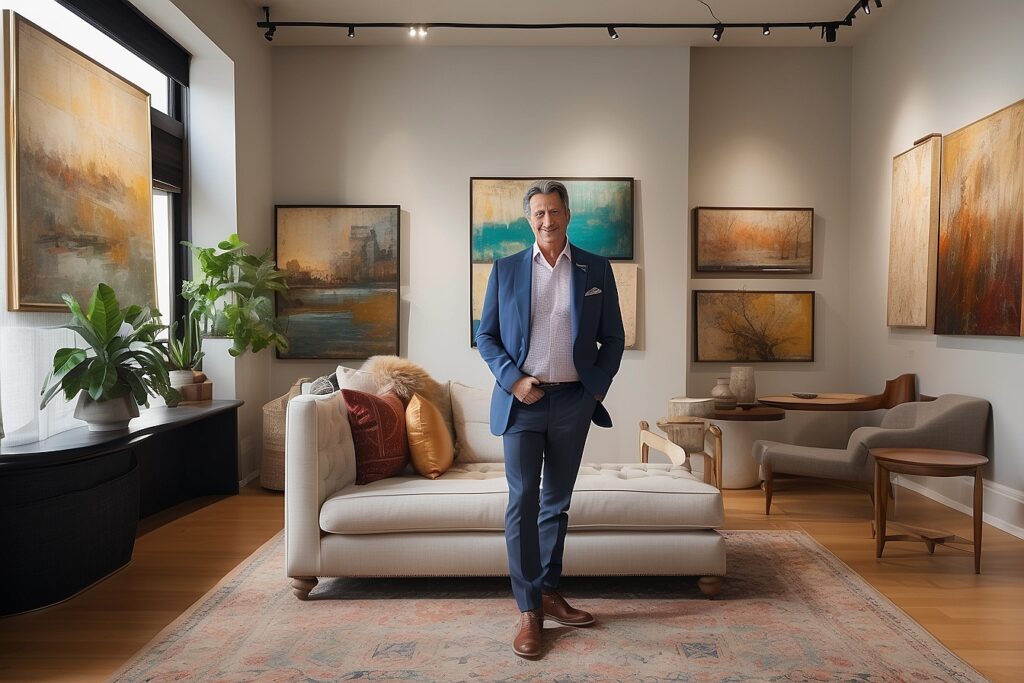James Yarosh Believes Monumental Art Pieces Energize Living Spaces and Inspire Resilience

Interior Designer and Gallery Owner Shares Passion for Art and Design
James Yarosh, a designer and gallerist, is deeply invested in the artists he represents, the collections he curates, and the spaces he crafts.
Drawing from his background in fine art, Yarosh approaches interior design with what he describes as “an artist’s eye,” emphasizing the importance of intuition in his creative process.
“Designing spaces is akin to an artist painting on a canvas,” Yarosh explained to Mansion Global. “It involves creating composition, selecting a color palette, and guiding the eye to narrate a story with focal points and subplots, resulting in an engaging living environment.”
For Yarosh, art is not merely decorative but serves as a profound influence that shapes his design philosophy. “Living with art in a thoughtfully designed home provides inspiration to confront life’s challenges,” he emphasized. “It serves as a reminder that beauty is omnipresent.”
Yarosh embarked on his journey into the gallery world at a young age, managing several galleries in New York and New Jersey by the age of 17.
His innate passion for art and his ability to convey its significance to others propelled him forward. “Sharing the art that resonates deeply with me is exhilarating,” he expressed. “Living with fine art has a transformative effect.”
In 1996, Yarosh established his own gallery in Holmdel, New Jersey, transitioning seamlessly into the intersection of art and interior design.
“Opening my gallery allowed me to collaborate with interior designers, suggesting art for their projects,” he recalled. “Expanding into interior design felt natural, as artists often possess the most intriguing homes.”
Yarosh’s global travels further enriched his creative vision, with museum visits and architectural explorations shaping his design sensibilities.
“Studying museum exhibitions and architectural marvels worldwide profoundly influenced my approach to interior design,” he noted. He draws inspiration from esteemed institutions such as the Louvre, the Leopold Museum, the National Portrait Gallery, and the Tel Aviv Museum of Art.
In conversation with Mansion Global, Yarosh delved deeper into his artistic and design ethos, offering insights into his unique approach.
Mansion Global: How does your museum travel influence your design approach?
James Yarosh: Museum visits profoundly impact both my gallery curation and interior design. They inform my understanding of how design elements can elevate art in diverse settings, from opulent maximalist spaces to serene minimalist environments.
For instance, a recent trip to Amsterdam’s Rijksmuseum inspired the dark gray walls I incorporated into a townhouse project. This choice imparted a sense of warmth to the foyer while allowing the art collection to take center stage.
Your work often leans towards maximalism. What are your views on this style?
While I appreciate the simplicity of minimalism, my inclination towards maximalism stems from my passion for collecting. I see maximalism as a celebration of beauty—a way to showcase diverse elements that resonate with me.
Through careful curation and restraint, maximalism can be presented thoughtfully. Rather than chasing trends, I prioritize timeless beauty that endures over time.
What’s a key consideration when starting to curate an art collection for the home?
It’s crucial to understand the distinction between decorative pieces and fine art. Begin with an open mind, exploring art beyond your initial comfort zone.
Embrace the learning process and allow yourself to appreciate diverse artistic styles. Once you discover an artist that speaks to you, prioritize acquiring their most impactful or personally resonant pieces.
What’s a common misconception about displaying art that you encounter?
One prevalent misconception is the belief that smaller living spaces lack room for larger artworks. In reality, monumental pieces can be transformative in smaller settings.
They possess the power to expand and elevate the space, enveloping viewers in their presence. I advocate for thinking creatively and exploring unconventional solutions to maximize the impact of art within any space.
What’s your top recommendation for designing a room around a piece of art?
The approach varies depending on the scale of the project. For extensive renovations or new constructions, start by selecting large-scale artworks that inform the architectural details of the home. A captivating artwork can serve as a guiding force, inspiring the design of the entire space.
On a smaller scale, you can still transform a room by drawing inspiration from a single painting. Allow the colors and patterns of the artwork to dictate the palette and design elements of the room, leading to unexpected yet harmonious combinations.
How do you personally define luxury?
Luxury, to me, embodies the essence of living in a space that nurtures the soul and reinforces one’s self-belief every day. It’s about surrounding oneself with elements that bring joy—be it art, decor, literature, nature’s beauty, or beloved companions like pets.
A truly luxurious home resonates with the individual’s essence and supports the way they aspire to live. Returning home should evoke a sense of grounding and renewal, regardless of the worldly adventures one embarks on.



